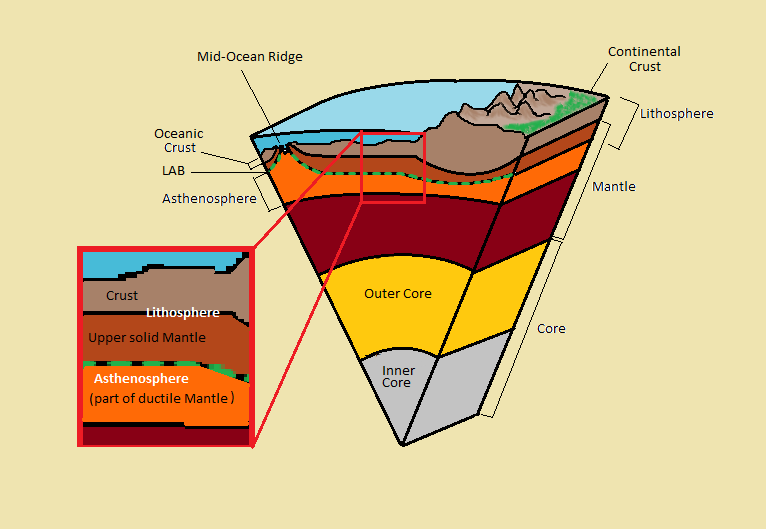
The outermost layer of the earth which is formed of solid rocks is called the ………………….
a. Soil
b. Crust
c. Core
d. Sial
Answer
551.7k+ views
Hint:
Earth's structure can be defined in two ways: according to mechanical properties such as rheology or chemistry. Mechanically, it can be divided into the lithosphere, asthenosphere, mesosphere mantle, outer core, and inner core. Chemically, the earth can be divided into the crust, upper mantle, lower mantle, outer core and inner core.
Complete solution:
The inner core: It is the centre and the hottest layer on earth. The inner core is solid and consists of iron and nickel with temperatures up to 5500 ° C. Due to its enormous thermal energy, the inner core is more like an engine room on earth.
The outer core: The earth's outer core resembles a very hot sphere of metal, where temperatures are between 4000 and 90,000 degrees Fahrenheit. It is so hot that the metal inside is liquid. Its outer core is approximately 1,800 miles beneath the crust and approximately 1,400 miles thick. It consists of metals such as iron and nickel. The outer core surrounds the inner core.

The mantle: The mantle is the widest part of the earth. Its thickness is about 2900 km. This mantle is mainly composed of a semi-liquid rock called magma. The rock is hard at the top of the mantle, but at the bottom softer and begins to melt.
The crust: The outermost or topmost layer of the earth is known as the earth's crust. The earth's crust is composed of sedimentary rock and granite. The average density of the earth's crust is 2.8 to 3. The outermost layers of the earth lie mainly beneath the continents.
Hence, the correct answer is option B.
Note:
The continental and oceanic crust is connected to the mantle, and this forms a layer called the lithosphere. This coating is cold and hard. Below the lithosphere is a hotter part of the mantle that is always in motion. This movement divides the lithosphere and causes volcanoes and earthquakes.
Earth's structure can be defined in two ways: according to mechanical properties such as rheology or chemistry. Mechanically, it can be divided into the lithosphere, asthenosphere, mesosphere mantle, outer core, and inner core. Chemically, the earth can be divided into the crust, upper mantle, lower mantle, outer core and inner core.
Complete solution:
The inner core: It is the centre and the hottest layer on earth. The inner core is solid and consists of iron and nickel with temperatures up to 5500 ° C. Due to its enormous thermal energy, the inner core is more like an engine room on earth.
The outer core: The earth's outer core resembles a very hot sphere of metal, where temperatures are between 4000 and 90,000 degrees Fahrenheit. It is so hot that the metal inside is liquid. Its outer core is approximately 1,800 miles beneath the crust and approximately 1,400 miles thick. It consists of metals such as iron and nickel. The outer core surrounds the inner core.

The mantle: The mantle is the widest part of the earth. Its thickness is about 2900 km. This mantle is mainly composed of a semi-liquid rock called magma. The rock is hard at the top of the mantle, but at the bottom softer and begins to melt.
The crust: The outermost or topmost layer of the earth is known as the earth's crust. The earth's crust is composed of sedimentary rock and granite. The average density of the earth's crust is 2.8 to 3. The outermost layers of the earth lie mainly beneath the continents.
Hence, the correct answer is option B.
Note:
The continental and oceanic crust is connected to the mantle, and this forms a layer called the lithosphere. This coating is cold and hard. Below the lithosphere is a hotter part of the mantle that is always in motion. This movement divides the lithosphere and causes volcanoes and earthquakes.
Recently Updated Pages
Master Class 12 Business Studies: Engaging Questions & Answers for Success

Master Class 12 Economics: Engaging Questions & Answers for Success

Master Class 12 English: Engaging Questions & Answers for Success

Master Class 12 Maths: Engaging Questions & Answers for Success

Master Class 12 Social Science: Engaging Questions & Answers for Success

Master Class 12 Chemistry: Engaging Questions & Answers for Success

Trending doubts
What is meant by exothermic and endothermic reactions class 11 chemistry CBSE

Which animal has three hearts class 11 biology CBSE

10 examples of friction in our daily life

One Metric ton is equal to kg A 10000 B 1000 C 100 class 11 physics CBSE

1 Quintal is equal to a 110 kg b 10 kg c 100kg d 1000 class 11 physics CBSE

Difference Between Prokaryotic Cells and Eukaryotic Cells




